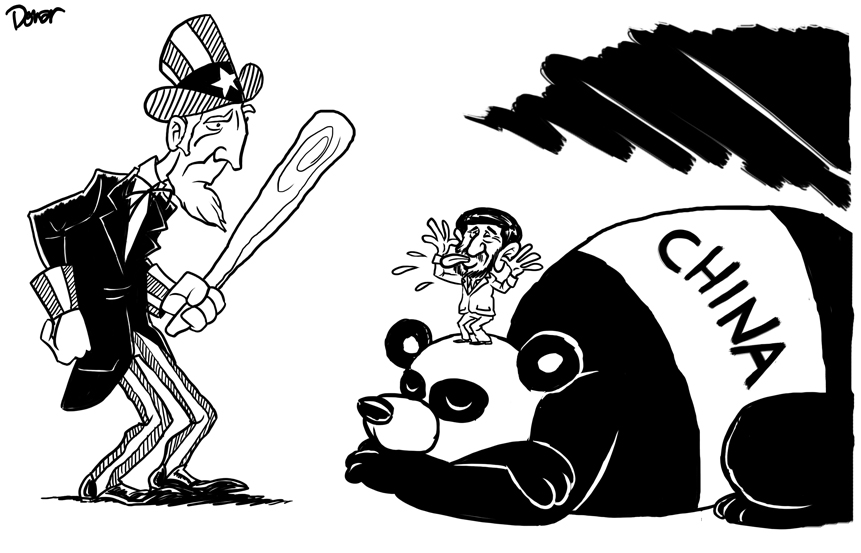Edited by Gillian Palmer

Since the opening pages of the Iranian nuclear issue and continuing more generally from the perspective of the exacerbating crisis between Iran and the West; amid Iran’s maneuvers in the Arab Gulf, including the threat to close the Strait of Hormuz; and in light of the American proclamations in response to the Iranian threats, a terrifying picture has been forming of what the scene in the region will be, especially if the American and Iranian factions are committed to putting into practice the scenarios in the myriad maneuvers, threats and mutual responses from both parties.
However, the Obama administration’s announcement of the new U.S. defense strategy made the possibility of this horrifying picture dissipate in a realistic and rational manner. Rather, this matter will be limited within the rigid confines of war; and Tehran will not risk crossing or going beyond the red line in this area, despite all of the naval maneuvers, missile threats and verbal skirmishes stemming from its controversial regional policy. Likewise, in reality, Washington will not go much further in the operation of choking Iran economically, so that it does not push Iran into such transgressions on the one hand and, on the other hand, it does not want to exacerbate this crisis to the extent that it encourages, with or without realizing it, the crystallization of a military alliance between Iran, Russia and China. This is especially so since its new strategy is heading toward the Far East with the goal of stopping the expansion of the Chinese giant’s influence in this region. Furthermore, the U.S. is acting in anticipation of preventing China from competing for unipolar leadership of the world. Prospective reports confirm that the worsening financial crisis in America and the multiplication in cuts in military spending as a result of this crisis could, at most, make China capable of seizing unipolar leadership from America in the future; at the very least, this guarantees the crystallization of multipolar leadership in the future, with China being one of its cornerstones. And so Washington, based on this strategy, will direct its military, political and economic weight toward southern Asia.
Thus, these new American tendencies envisage the beginning of engagement in a new Cold War in the Far East and the Pacific between China and America. Moreover, [with] Washington concentrating its interest on southern Asia through this strategy, more than on the Middle East and other regions; the American withdrawal from Iraq; the preamble of withdrawal from Afghanistan; and the consequent calming and taming of the Taliban movement so that they return to power in the country — perhaps one of the features of this strategy is to devote a greater amount of materials and to cultivate various interests [in southern Asia] in order to face China, to reduce its growing influence and stop the march of its ambitions in the region and in the rest of the world.
With this, America’s position will be concentrated in Asia; more attention will be on the Far East and the Pacific in all aspects: political, economic and military. This was confirmed by the Secretary of State Hillary Clinton in her interview with the American magazine Foreign Policy when she said, “Our priorities are to concentrate on the economic and strategic future of the United States of America and to consolidate our relationship with Asia, since necessity dictates facing the growing influence of China in the region.”* The American secretary of state added, “Over the next 10 years, we need to be smart and systematic about where we invest time and energy, so that we put ourselves in a better position to sustain our leadership, secure our interests and advance our values. One of the most important tasks of American statecraft over the next decade will therefore be to lock in a substantially increased investment — diplomatic, economic, strategic and otherwise — in the Asia-Pacific region.”
It is worth mentioning in this context that U.S. President Obama was the first to implement this new strategy — before it was announced — when he participated in the recent Asia-Pacific Economic Cooperation Summit held in Hawaii. China refrained from attending, but Obama was the first American president to attend this kind of summit.
There is no doubt that the announcement of America’s new strategic direction made observers and analysts look into the extent of residual American interest in the Middle East after the new tendency was revealed. Moreover, it is true that the American administration’s current message does not forget Washington’s commitment to regional issues in terms of security, stability and peace. However, the American news network ABC confirmed, regarding this matter, that Washington began to abandon the Middle East to support its dreams of leadership and progress — toward its ambition of taking over the southern Asian continent.
In any case, signs of the new Cold War remain confined to southern Asia; although this limitation does not mean Beijing’s anti-Washington stances aren’t developing in the Middle East. Meanwhile, Washington will not seek to delve into a new war in the region after its experiences in Iraq and Afghanistan, since what is going on between the U.S. and Tehran at this time remains in a state of preparation for rigid war that may end in bargains and agreements between the two sides.
*Editor’s Note: This quotation, accurately translated, could not be verified.

Leave a Reply
You must be logged in to post a comment.